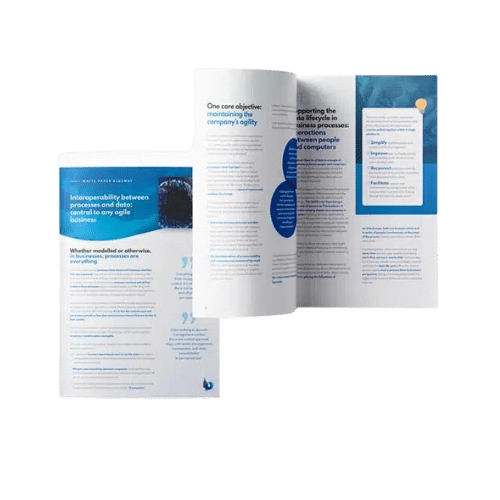ERP (Enterprise Resource Planning) and WMS (Warehouse Management System) both meet crucial requirements, and each fits neatly with the other. Data often needs to be consolidated between the grassroots level and overviews at a higher level to speed up order processing and improve stock planning. Communication between ERP and WMS has an impact not only on how the business is organised, but likewise on the information system. For this link between applications to be efficient and not deteriorate as time passes, a robust and upgradeable solution should be implemented.
ERP, the central access point to business data
ERP lies at the heart of manufacturing organisations, and many other industries besides. This potent management and coordination system centralises functional data and monitors activities in real time. Its company-wide reach and modular dashboard make it the go-to solution for decision-makers and functional business managers.
ERP meets the need for data consolidation and traceability, with financial information, purchasing, production, schedules, etc. Manufactured output is consequently tracked from design to shipping, and product compliance is more certain.
This integrated management package helps rationalise costs, by reducing errors and providing decision support, businesses keep better control over their projects and their production processes.
ERP has a profound influence over the information system. Forming the core of the IS, it offers an access hub to a major proportion of the business’ data, which fundamentally simplifies the use of multiple business data sources. It therefore makes sense for businesses to want to connect it to other applications in their information systems.

How process (BPM) and data (ESB) integration can create value for IT and business departments ?
WMS, the grassroots solution that transforms warehouse management
Those other applications include WMS, or Warehouse Management System. This package structures and supports order preparation, optimising the available space and improving the quality of the packages shipped. It introduces invaluable smart management to warehouses for businesses with sustained levels of activity.
Sometimes wrongly confused with ERP, a WMS is actually a dedicated application offering advanced functionalities concerning supplies, storage, inventory and order picking. The crucial role played by a WMS is to properly match resources (available space, order pickers, hauliers, etc.) with business requirements and strategy.
It is therefore a system with a high impact on the effectiveness of stock management. By streamlining warehouse management, a WMS means improved anticipation of future demand and requirements, and better use made of resources.
The much-needed communication between two crucial systems: ERP and WMS
These two systems, occupying crucial roles in the IS, therefore absolutely must communicate to deliver the best possible performance. Integrating these applications is all the more important given that warehouse management depends on data from ERP, and vice versa:
- For the business, warehouse management affects the human resources to be used, finance requirements to be anticipated, and production processes and storage to be orchestrated to optimise the space available. WMS provides accurate data (stocks, goods inwards and outwards) that helps to reduce the levels of costly, unused stocks held, and contributes to business management more generally.
- For the warehouse, processes are dependent on what the business is able to provide and the level of stock operations (orders, additional products) from ERP. ERP is where the decisions are made, and relevant data is then provided so that warehouse processes are run accordingly. The aim is to improve storage capacity, eliminate tasks serving little or no purpose, and therefore reduce costs.
Communication between ERP and WMS thus pools two business views, one more strategic and high-level, the other more granular and operational. But both must communicate on the same terms and get data circulating in real time.
For this, it will be necessary to:
Harmonise the “language” used by the two systems:
WMS needs to have ERP codes and practices available to harmonise with the processes used
Avoid duplicate dataes doublons:
Entering a piece of information in both ERP and the WMS can potentially result in duplicates. Reconciliation should be automated, and orchestrating data flows between the systems should mean errors are avoided.
Instantly inform the other system when major changes occur:
Special orders, stockouts and other events with a serious business impact must be swiftly reported between the systems
DisposProvide a complete product database:
both systems must work in synergy so that all products are listed and full use can be made of product characteristics by the WMS. This requires a logistics profile of products to be made available (properties, batches, packaging, etc.)

ESB vs ETL ? The distinction between is no longer relevant relative to today’s business requirements.
Re-engineer the IS to coordinate interaction between ERP and the WMS
The objective of linking ERP and WMS is to introduce instant data interchange and not restrict functional processes to the scope of a single application. This will contribute to better choices in terms of product storage, and flawless orchestration for order preparation, including automated re-stocking, systematic quality controls, thresholds for triggering notifications, etc. Once added into ERP, the data and warnings form a basis for improving product supply, and working methods.
But while it acts as a unifier and is undoubtedly potent, ERP is not itself intended to deliver this communication between applications. Often wrongly viewed by businesses as an integration platform, ERP is sometimes linked to other business applications via standard or custom connectors, causing an increase in the number of point-to-point interfaces. However, while ERP is a lynchpin of the IS and supports transactional processing, it is not designed to unify and transport data.
Changes in business practices and data formats, or changes in application components, should not prevent interaction between ERP and a WMS.
Consequently, to ensure the solution chosen will last the course, the key point is to choose flexibility. Application components must be able to be removed or changed as the business develops. ERP and WMS can accordingly evolve with the business, with changing or obsolete applications posing no obstacle.
With its comprehensive approach to data interchange, in particular through an application bus (ESB), Blueway provides a flexible, upgradeable, supervised relationship between the ERP and WMS applications. ERP can exchange full, up-to-date data with the WMS or any other functional business application at any time. Doing so avoids the use of somewhat rigid point-to-point interfaces: the IS is re-engineered around a central system and can be enhanced as and when requirements arise.
This re-engineering ensures data is supplied to all business processes. Far from being limited to a functional business scope, data can be fully exploited, and not restricted to one application alone. Modelling processes using BPM can then help with the strategic distribution of business data to all those who need it, regardless of the constraints of any software component.
In this way, it is not only the information system itself that is rationalised, but also the organisation and its processes. The application bus ensures that the information system genuinely serves the business, and each component application, led by ERP and WMS. A key issue in today’s business performance.

Want to discuss interoperability challenges with an expert?





